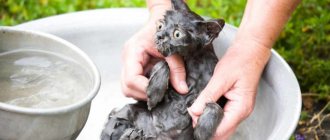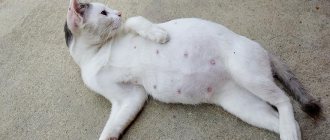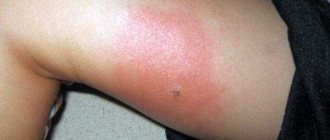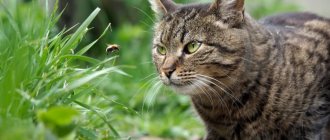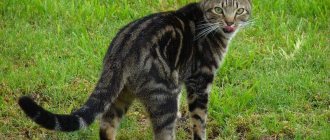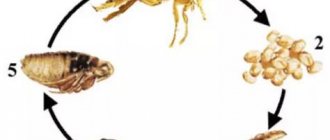At the moment, many owners of pets that have dog or cat fleas use tar soap. It consists of birch tar, which has many different healing properties.
Below, the article details how and on which flea-infested animals you can use tar and other insecticidal soaps.
Is it suitable for cats?
In addition to special shampoos intended for hair and skin care, there are drugs whose action is aimed at destroying parasites or fungus. Many cat owners refuse pharmaceutical products, preferring tar soap, because... this product has a number of useful properties.
When used correctly, this soap accelerates the process of cell regeneration and relieves irritation of the epidermis. It has anti-inflammatory and antibacterial effects. The smell of a hygiene product can repel parasites, which serves as a prevention of flea infestation.
But tar soap cannot be used regularly for the procedure either. The choice in favor of this product should be made if there is no special means for washing the animal at home.
Which soap is better, liquid or solid?
You can wash your cat with tar soap without any worries. Both traditional bars and a liquid equivalent are used. Each type has its own characteristics. Hard soap foams worse, but has a more natural composition. Liquid detergent forms a thick foam, but contains synthetic additives that negatively affect the condition of the skin.
Liquid
Does it help remove fleas?
Soap containing birch tar does not provide a 100% guarantee of killing parasites. The product will only be effective under certain conditions. For example, if a cat has been in contact with another animal that has fleas, then preventive treatment is required immediately after a walk.
It is necessary to bathe the pet. If he was infected, then 1 procedure will be enough. Parasites can be washed or combed out. Benzene, which is contained in tar, is a toxin for insects. It affects the nerve centers of fleas. Therefore, the parasites become lethargic (sedentary).
If a cat has a severe flea infestation, then several treatments will be required to treat head lice. The animal must be soaped and wait 5 minutes. During this time, some of the fleas will leave the fur on their own (will end up in the water), while others will become inactive. The remaining parasites are combed out.
But soap only has a negative effect on adults, and not on their eggs. Therefore, it will be necessary to re-treat in a few days when the nits hatch.
Do the premises need to be treated?
If fleas are found on animals, then there is a high probability that they are already settling in the apartment, hiding in secluded places. They are waiting for the right moment to attack animals or humans again. These insects are quite difficult to catch, and hardly anyone wants to endure their bites.
Therefore, you need to think about protecting your home from these parasites. You can use both effective chemicals and folk remedies. Along with substances such as vinegar, lavender, wormwood, tansy, etc. Tar soap will help protect your apartment. If this soap is used for washing floors and treating various surfaces, then fleas and other parasites will gradually disappear from the apartment. Although the aroma from using tar soap is specific, you still have to choose which is better. After treating the apartment, it is better to ventilate it thoroughly.
But if pregnant women, small children, or people with allergies live in the apartment, then it is better to opt for other substances that do not have a specific aroma.
Is it effective against lichen?
Tar reduces the activity of bacterial and fungal microflora, so soap containing this element can be used to treat lichen in cats. To cure an animal, apply foam to the affected area and leave for 15 minutes.
You can also make pasta. You will need to rub the bar, fill it with warm water, and then wait until the crushed particles are completely dissolved. You should get a homogeneous mass. It is applied daily to the lichen, and after 15-20 minutes it is washed off with water.
Sulfur-tar ointment
For a dermatological disease, a veterinarian may recommend sulfur-tar ointment. In addition to tar, it contains substances that will help speed up the process of treating lichen (turpentine, lanolin, sulfur, zinc oxide, salicylic acid, Lysol and petroleum jelly).
Before use, the cat’s hair is not cut. The ointment is applied to the affected area, and also treated 2-3 cm beyond the contour of the lichen (around). Forcibly, i.e. You cannot remove the crusts yourself. The site of infection is treated 1-2 times a day.
In most cases, a positive result is observed on the 7-10th day of treatment. The crusts begin to separate, and the hairline is restored (grows).
Harm and contraindications
Soap containing tar is considered a fairly safe product, but also has contraindications. It is not recommended for washing kittens that are not yet 6 weeks old. You should refrain from using the hygiene product if the cat has an individual intolerance to tar or other components included in its composition.
Soap can be harmful to your cat if the foam gets into your cat's eyes. It will cause pain. To eliminate the irritating factor, the animal's eyes are washed with clean water. If soap gets into the mouth or digestive tract, your pet may experience symptoms of stomach upset. Sometimes he can be lethargic.
If an animal has eaten a lot of soap, then it shows signs of poisoning. In such a situation, you need to take the cat to the veterinarian. Gastric lavage may be required.
Frequent use of soap can cause dermatological problems. Despite the antiseptic, wound-healing effect, the hygiene product dries out the skin. Therefore, with frequent bathing, the cat may experience irritation from drying out of the epidermis.
Precautionary measures
When using insecticidal tar soap, the owner of a cat or dog observes the following precautions:
- make sure that flea soap does not accidentally get into the eyes of a cat or dog;
- treats an infected pet only in the bathroom, without closing the door to this room;
- Do not wash your pet again if it has an allergy to a particular flea soap. In such a situation, the owner of the cat or dog, together with the veterinarian, selects another means to remove such parasites.
It is better for allergy sufferers not to carry out such treatment on their cats and dogs themselves, but to entrust this matter to their relatives or use tar soap for animals without a specific unpleasant aroma.
Failure to comply with such rules leads to the formation of severe allergies.
Shampoo
Tar shampoo intended for animals can be purchased at a veterinary pharmacy, pet store or supermarket, i.e. the product is publicly available. This product is often marketed as a flea and tick product. You can choose from:
- Celandine;
- Magic pet;
- Doctor;
- Luxury;
- Degtyarny (Nevskaya cosmetics);
- Home doctor.
The difference between shampoo and soap may be in the composition, but not always. Additional substances, such as dyes or fragrances, are often added to the first product. Not all of them are safe for the animal, because... may cause an allergic reaction.
When choosing between soap and shampoo, you should carefully study the composition. If the cat does not have individual intolerance to the components, then you can use any form of release.
Many owners prefer to use shampoo because... it's easier to apply.
general description
The choice of specialized flea products is simply huge. Modern products are presented in different forms of release and have many advantages and features. But there are also disadvantages, which are the reason for refusing to use them on your pets. The fact is that such specialized products are toxic pesticides that cannot be called harmless, which poses a danger to animals and even people.
They can cause side effects and allergic reactions that the manufacturer does not indicate, since no one knows how the body will react to a particular drug. In addition, most of these drugs are not intended for use on kittens and puppies, pregnant and lactating bitches, weakened or sick animals.
Regarding tar soap, it can be used from the 5th week of an animal’s life and not worry about its health. This remedy has no side effects and is suitable for animals that are sick. Of course, this soap is not highly effective, like modern drugs, but it is absolutely safe.
How to wash?
The cat can be bathed 2 times a month. Water procedures should be abandoned if the animal:
- pregnant;
- sick;
- was recently vaccinated.
If the pet has just eaten, then it is better to postpone bathing for 2-3 hours.
To make the cat feel comfortable during water procedures, preference should be given to a small bath. You need to lay a rug on its bottom. It will prevent the animal's paws from slipping. Water is drawn up to the level of the pet’s chest. It should be warm, not exceed +38°C.
The cat is lowered into the prepared bath. It is not recommended to collect water while the animal is inside. This bathing option is suitable for pets who love such procedures.
The animal's fur is well moistened with water and then soaped. Shampoo or soap containing tar is immediately applied to the coat. There is no need to pre-dilute the detergent in water. It is not recommended to wet or soap your hair.
For the product to work, it must be left on the fur for 5-10 minutes. When the time is up, the animal is rinsed with clean water. The foam is washed thoroughly. It should not remain on the fur, because... may get on the mucous membrane.
When the water procedure is completed, the cat is wrapped in a dry towel and taken to a warm room. Additionally, you can turn on the heater to prevent your pet from freezing. You should not let the animal out of the warm room until it is dry. Otherwise, there is a risk that the cat will get sick.
Which is better: chemical flea preparations or folk remedies?
The main advantage of folk methods of getting rid of blood-sucking insects is accessibility. Almost every home has garlic, and you can buy chamomile, wormwood essential oil or herbal mixture at the nearest pharmacy or supermarket.
Using folk remedies (especially oils, wormwood or garlic), prepare for a strong and persistent smell in the house. Some animals (especially puppies and kittens) do not tolerate them well. Oils can cause allergies or rashes, and some substances (tansy, boric acid and vinegar) can cause severe poisoning. When using such drugs, you should be especially careful, follow the recommended dosages and monitor the behavior and condition of your pet.
Under no circumstances should your pet be allowed to lick its fur: even a small amount of herbs and oils with a strong odor can cause vomiting, diarrhea and worsening of the condition. Traditional methods of getting rid of parasites are safer in this regard: shampoos, sprays, tablets and drops on the withers.
Many products are very inexpensive, but do not cause allergies or side effects. They can be used even by babies (from 2 weeks), nursing and pregnant cats and dogs. Such products are also made on the basis of natural ingredients, herbs and oils, which care for the coat and make the combing process easy and enjoyable.
Immediately after identifying fleas on an animal, you must begin to fight them.
Reviews
Svetlana Vasilievna, 46 years old, Moscow:
“At the dacha, the cat picked up shingles somewhere. Due to the lack of opportunity to go to the city, i.e. to a veterinary pharmacy, I had to turn to traditional medicine methods. Apply tar soap foam to the affected area, rub in, and then wash off.
Additionally, after each soaping, I treated it with iodine. In this way, we managed to cure lichen in a week.”
Ivan Markovich, 77 years old, Novosibirsk:
“There were always cats at home, 2-3 each. Therefore, I had to deal with the problem of fleas more than once. When signs of parasites were noticed in one of the pets, everyone was immediately bathed with tar soap.
Now there is one cat living at home, which has access to the street. I also bathe her periodically with tar, but this time with shampoo, because... it is more convenient to use. A positive result is always visible after 1-2 procedures.”
Marina Sergeevna, veterinarian, Petro.
What to replace it with?
For bathing adults and kittens, it is better to use special products that are intended for animals. When making them, the pH of the pet's skin is taken into account. When choosing a hygiene product, you should always look at the manufacturer’s information about the age at which a cat can be bathed and any contraindications.
If you don’t have tar shampoo or soap at home, and you can’t purchase a special veterinary remedy, dust soap is a good remedy for parasites and skin diseases. This product allows you to destroy not only fleas, but also their eggs.
Tar shampoo, like soap, has a repulsive odor. It is unpleasant not only to insects, humans, but also to the cat itself. For this reason, you should not keep the animal lathered with this composition for a long time.
After bathing, you should not try to mask the smell of soap with another product, such as perfume. For your pet, this aroma will also be unpleasant and irritating. It is necessary to allow the cat to tidy up its fur on its own (by licking).
Comparative characteristics
Many pet owners have 1 of 2 types of soap in their home - laundry or tar. Fleas Ctenocephalides canis or Ctenocephalides felis are also well killed by such products as dust and green soap.
Such insecticidal products are also inexpensive, have various beneficial properties and instantly destroy various parasites on dog or cat fur.
What soap should you use to wash your dog or cat? A detailed answer to this question is given below.
Degtyarnoe
Tar soap is considered a cosmetic cleanser, which is most often used when fighting cat or dog fleas (Ctenocephalides felis or Ctenocephalides canis). This product repels dog and cat fleas with its disgusting, pungent odor.
Tar soap has the following advantages:
- is a product made from natural raw materials, which is filled with birch tar;
- disinfects and also calms the animal;
- has low cost.
Economic
Laundry soap quickly cleans surfaces from various dirty stains and also destroys various microbes.
Such an insecticidal agent has the following advantages:
- is an environmentally friendly and hypoallergenic product;
- has a high alkaline balance;
- quickly destroys various microbes;
- has a low price.
Is it possible to completely remove Ctenocephalides canis or Ctenocephalides felis fleas using this product? No, because flea soap does not kill these parasites in cats or dogs at all, but only scares them away.
As a result, after using such a product, small pests leave the pet’s body and begin to jump around the bathroom or on clothes. In this case, they must be killed quickly before they spread throughout the apartment.
Dustovoe
Dust soap quickly and permanently destroys lice, various fleas or other similar insects. If laundry or tar soap is used at least 2 times, then it is enough to use dust soap 1 time to get the desired result.
However, doctors prohibit a person from frequently using such an insecticidal agent, because it gradually accumulates in the body of a cat, dog or person, which leads to its intoxication.
Will tar soap help against fleas? Yes.
The effectiveness of the product in the fight against fleas Ctenocephalides canis and Ctenocephalides felis is as follows:
- with a single use, it quickly calms the animal;
- damages the shells of flea eggs and then kills them;
- has a low cost.
At the same time, such a tool has several of the following disadvantages:
- very toxic;
- when accumulated in a human or animal body, it seriously disrupts the functioning of various organs;
- dangerous for children (both human and animal).
Green
Green soap for fleas Ctenocephalides canis and Ctenocephalides felis is an insecticidal preparation that is safe for humans and plants and effectively destroys these pests.
Such a tool has the following advantages:
- is an independent preparation that is used together with specific other insecticides, various bactericides or fungicides;
- does not harm the health of animals or humans;
- forms a film on the skin of 1 flea that blocks the flow of oxygen into the body of this parasite, as well as into its larvae and eggs.

